ISSN ONLINE(2319-8753)PRINT(2347-6710)
ISSN ONLINE(2319-8753)PRINT(2347-6710)
Chandan Kumar1, Krishna Murari2, C.R.Sharma2.
|
| Related article at Pubmed, Scholar Google |
Visit for more related articles at International Journal of Innovative Research in Science, Engineering and Technology
The present paper reports result of an experimental program conducted to study the behavior of geopolymer concrete at elevated temperature on the basis of physical appearance, weight loss and residual compressive strength test. The geopolymer concrete cubes of 150×150×150 mm were cast. Three cubes were tested for compressive strength at the age of 7 days and 28 days by universal testing machine. Then the specimen were subjected to the elevated temperature 200oc, 400oc, 600oc, 800oc and 1000oc in an electric air heated muffle and after cooling were tested for the compressive strength. Six cubes were immersed in each solution of sodium sulphate, sulfuric acid, and sodium chloride for 30 days and 60 days. The test reveal the properties of geopolymer concrete and its applicability at elevated temperature and against aggressive environment such as acid attack, sulphate attack and chloride attack.
Keywords |
| Elevated temperature, Residual strength, Aggressive chemical environment, Geopolymer concrete |
INTRODUCTION |
| Concrete usage around the world is second only to water. Ordinary Portland cement (OPC) is conventionally used as the primary binder to produce concrete. The environmental issues associated with the production of OPC are well known. The amount of the carbon dioxide released during the manufacture of OPC due to the calcination of limestone and combustion of fossil fuel is in the order of one ton for every ton of OPC produced. In addition, the extent of energy required to produce OPC is only next to steel and aluminum. |
| On the other hand, the abundant availability of fly ash worldwide creates opportunity to utilize this by-product of burning coal, as a substitute for OPC to manufacture concrete. When used as a partial replacement of OPC, in the presence of water and in ambient temperature, fly ash reacts with the calcium hydroxide during the hydration process of OPC to form the calcium silicate hydrate (C-S-H) gel. |
| In 1978, Davidovits (1999) proposed that binders could be produced by a polymeric reaction of alkaline liquids with the silicon and the aluminium in source materials of geological origin or by-product materials such as fly ash and rice husk ash. He termed these binders as geopolymers. Palomo et al (1999) suggested that pozzolans such as blast furnace slag might be activated using alkaline liquids to form a binder and hence totally replace the use of OPC in concrete. |
| In this work, low-calcium fly ash-based geopolymer is used as the binder, instead of Portland or other hydraulic cement paste, to produce concrete. The fly ash-based geopolymer paste binds the loose coarse aggregates, fine aggregates and other un-reacted materials together to form the geopolymer concrete, with or without the presence of admixtures. The manufacture of geopolymer concrete is carried out using the usual concrete technology methods. |
LITERATURE REVIEW |
| Palomo et al (1999) studied the geopolymerisation of low-calcium ASTM Class F fly ash (molar Si/Al=1.81) using four different solutions with the solution-to-fly ash ratio by mass of 0.25 to 0.30. The molar SiO2/K2O or SiO2/Na2O of the solutions was in the range of 0.63 to 1.23. The specimens were 10x10x60 mm in size. The best compressive strength obtained was more than 60 MPa for mixtures that used a combination of sodium hydroxide and sodium silicate solution, after curing the specimens for 24 hours at 65oC. |
| Xu and van Deventer (2000) reported that the proportion of alkaline solution to alumino-silicate powder by mass should be approximately 0.33 to allow the geopolymeric reactions to occur. Alkaline solutions formed a thick gel instantaneously upon mixing with the alumino-silicate powder. The specimen size in their study was 20x20x20 mm, and the maximum compressive strength achieved was 19 MPa after 72 hours of curing at 35oC with stilbite source material. |
| van Jaarsveld et al (1998) reported the use of the mass ratio of the solution to the powder of about 0.39. In their work, 57% fly ash was mixed with 15% kaolin or calcined kaolin. The alkaline liquid comprised 3.5% sodium silicate, 20% water and 4% sodium or potassium hydroxide. In this case, they used specimen size of 50x50x50 mm. The maximum compressive strength obtained was 75 MPa when fly ash and builders waste were used as the source material. |
| Davidovits (1982) and Barbosa et al (2000) prepared seven mixture compositions of geopolymer paste for the following range of molar oxide ratios: 0.2<Na2O/SiO2<0.48; 3.3<SiO2/Al2O3<4.5 and 10<H2O/Na2O<25. From the tests performed on the paste specimens, they found that the optimum composition occurred when the ratio of Na2O/SiO2 was 0.25, the ratio of H2O/Na2O was 10.0, and the ratio of SiO2/Al2O3 was 3.3. Mixtures with high water content, i.e. H2O/Na2O = 25, developed very low compressive strengths, and thus underlying the importance of water content in the mixture. There was no information regarding the size of the specimens, while the moulds used were of a thin polyethylene film. |
| Teixeira-Pinto et al (2002) found that the fresh geopolymer mortar became very stiff and dry while mixing, and exhibited high viscosity and cohesive nature. They suggested that the forced mixer type should be used in mixing the geopolymer materials, instead of the gravity type mixer. An increase in the mixing time increased the temperature of the fresh geopolymers, and hence reduced the workability. To improve the workability, they suggested the use of admixtures to reduce the viscosity and cohesion. |
| Teixeira-Pinto et al (2002) concluded that Vicat needle apparatus is not appropriate to measure the setting time of fresh geopolymer concrete, Chen and Chiu (2003) reported the only information available to date on the quantitative measure of the setting time of geopolymer material using the Vicat needle. For the fresh geopolymer paste based on metakaolin and ground blast furnace slag, they measured the setting time of the geopolymer material both at room and elevated temperature. In the elevated temperature, the measurement was done in the oven. They found that the initial setting time was very short for geopolymers cured at 60oC, in the range of 15 to 45 minutes. |
| Barbosa et al (1999) measured the viscosity of fresh metakaolin-based geopolymer paste, and reported that the viscosity of the geopolymer paste increased with time. Most of the manufacturing process of making geopolymer paste involved dry mixing of the source materials, followed by adding the alkaline solution and then further mixing for another specified period of time (van Jaarsveld et al. 1998; Swanepoel and Strydom 2002; Teixeira-Pinto et al. 2002). |
1.1 Geopolymer Materials |
| Geopolymers are inorganic polymeric binding materials. Joseph Davidovits, coined the term “geopolymer” in 1978 to classify the newly discovered geosynthesis that produces inorganic polymeric materials. |
| The chemical composition of the geopolymer material is similar to natural zeolitic materials, but the microstructure is amorphous. Geopolymer material with sodium hydroxide and cured at elevated temperature will attributed more stable cross- linked alumino silicate polymer structure. The properties and uses of geopolymers are being explored in many scientific and industrial disciplines. |
EXPERIMENTAL PROGRAM |
A. Materials |
| The material used in present investigation were locally available in Sindri, Dist- Dhanbad(Jharkhand) and physical properties were found through various laboratory tests conducted in Concrete and Road material lab, B.I.T Sindri. |
III.A.1 Fine aggregate |
| Ordinary sand available in Sindri, Dhanbad (Damodar river sand) having the following characteristics has been used. |
| Specific gravity : 2.67 |
| Fineness modulus : 2.42 |
| Unit weight : 1.674 gm/cc |
| Water absorption : 0.44% |
| Bulking : 26% |
| Sand after sieve analysis confirm to zone – II as per IS 383-1970. |
III.A.2 Coarse aggregate |
| Locally available black crushed stone (Pakur stone) in Sindri with maximum nominal size of 20 mm and 10 mm have been used as coarse aggregate. The physical properties for the coarse aggregate as found through laboratory test according to IS 2386-1963 is resulted as: |
| Aggregate crushing value = 24% |
| Aggregate impact value = 29% |
| Specific gravity = 2.64 |
| Water absorption = 0.94% |
| Unit weight = 1.60gm/cc |
| Fineness Modulus = 6.15 |
III.A.3 Fly ash |
| Low calcium fly ash samples taken from Bokaro Thermal Power Station, Bokaro (Jharkhand) were used in this study. This fly ash was of average quality formed with the combustion of lignite and bituminous coal. The colour of the fly ash was light grey. The sample satisfied the requirements of IS 3812(Part I). |
| The chemical characteristics are presented in table 2.4. The chemical property of the fly ash has been presumed based on the data made available from Bokaro Thermal Power Station, Bokaro (Jharkhand). |
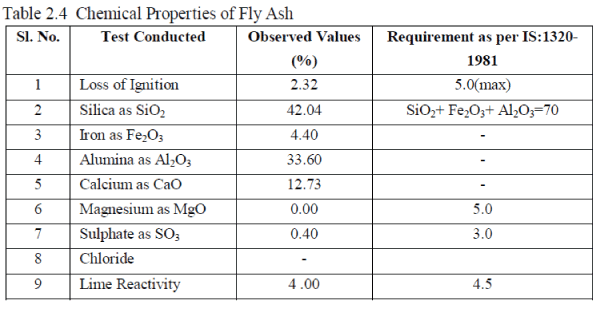 |
III.A.4 Chemical Solution |
| A combination of sodium silicate solution and sodium hydroxide solution was chosen as the alkaline liquid. Sodium-based solutions were chosen because they were cheaper than Potassium-based solutions. Both were commercially available in market. |
Sodium hydroxide |
| The sodium hydroxide (NaOH) solution was prepared by dissolving the pellets in water. The mass of NaOH solids in a solution varied depending on the concentration of the solution expressed in terms of molar, M. For instance, NaOH solution with a concentration of 8M consisted of 8x40 = 320 grams of NaOH solids (in flake or pellet form) per litre of the solution, where 40 is the molecular weight of NaOH. The mass of NaOH solids for 97% purity was measured as 260 grams per kg of NaOH solution of 8M concentration. Similarly, the mass of NaOH solids per kg of the solution for other concentrations were measured as 10M: 314 grams, 12M: 361 grams, 14M: 404 grams, and 16M: 444 grams. Note that the mass of NaOH solids was only a fraction of the mass of the NaOH solution, and water is the major component. Further through literature review it was strongly recommended that the sodium hydroxide solution must be prepared 24 hours prior to use as it terminates to semi solid liquid state after 36 hours. The same recommendation was adopted in the present work. |
Sodium silicate |
| Sodium Silicate was available in semisolid form. The sodium silicate solution (Na2O= 14.7%, SiO2=29.4%, and water=55.9% by mass) was purchased from a local supplier in bulk. |
III.A.5 Water |
| Distilled water was used throughout the test procedure to achieve exact molarity. |
B. Mix design of Geopolymer Concrete |
| As in the case of Portland cement concrete, the coarse aggregates and fine aggregates occupy about 75%-80% mass of Geopolymer concrete. Assuming the aggregates to be in surface saturated dry condition and the unit weight of concrete is 2400 Kg/m3. Combined aggregates are assumed to consist of 70% coarse aggregate and 30% fine aggregate. The mix proportion for 14 M geopolymer concrete is calculated and the value of different ingradients for one cubic meter concrete by mass is given as: |
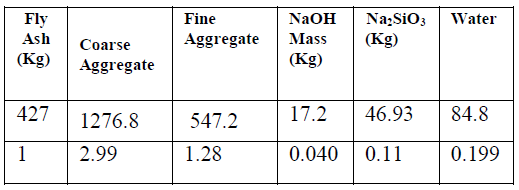 |
C. Mixing and casting procedure |
| The specimen were prepared according to IS 516-1959. Mixing of all the material were done manually in the laboratory at room temperature.The coarse aggregates, fine aggregates and fly-ash were weighed and placed on the mixing floor, moistened in advance and mixed homogeneously. After mixing these ingradient, weight the water and placed on the dry mix. simultaneously place the geopolymer binder which is homogeneous mixture of sodium hydroxide and sodium silicate prepared 24 hrs prior tan mixing. The mixing of total mass was continued until the binding paste covered all the aggregates and mixture become homogeneous and uniform in colour. Fresh concrete was cast in steel mould and each cube specimen was cast in three layers by compacting manually(as shown in fig 2.2) as well as by using vibration table as shown in fig.(2.3). Each layer received 35 strokes of compaction by standard compaction rod for concrete, followed by further compaction on the vibration table. The cube specimens of size 150×150×150 mm size were used for compressive strength determination after demoulding at one day, the specification were kept in hot air oven at 80oc until 24 hrs age and then cured in air with a temperature of 20oc and 50% relative humidity. The mould were removed and kept at room temperature until the time of the experiment. |
 |
RESULTS AND DISCUSSION |
| The experimental results are presented and discussed. Each of the compressive strength test data plotted in Figures or given Tables corresponds to the mean value of the compressive strengths. The effects of elevated temperature and aggressive chemical environment on the compressive strength and weight loss of geopolymer concrete composite are discussed. |
A. Compressive strength at elevated temperature |
| Compressive strength of concrete is directly determined with the help of universal testing machine in concrete and road material laboratory, BIT Sindri. The thermal stability of geopolymer concrete material prepared with sodium containing activators rather low and significant changes in the microstructure occurred. At 1000oC,the strength of the concrete was reduced due to increase in the average pore size where amorphous structure were replaced by the crystalline Na-feldspars. Fly ash based geopolymer prepared using class F fly as wit sodium silicate shows high shrinkage as well as lare canes in compressive strength with increasing fire temperature in the range 800-1000oC. |
| The compressive strength for different conditions is given in table 4.1 |
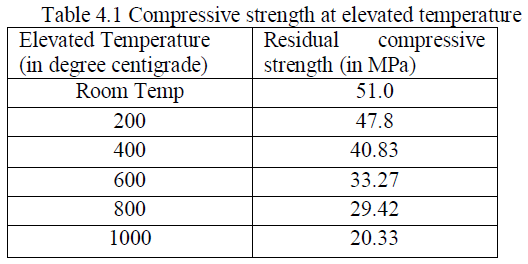 |
Compressive strength against aggressive environment |
| Three numbers of specimens in each acid, sulfate and chloride solution were tested for compressive strength after curing time and unit weight of specimens was noted before the test. Sulphuric acid attacks to lead to deposition of a white layer of a gypsum crystal on the acid exposed surface of the specimen. The average test results are presented in table 4.2 and corresponding diagram is plotted as shown in fig 4.2 for geopolymer concrete. |
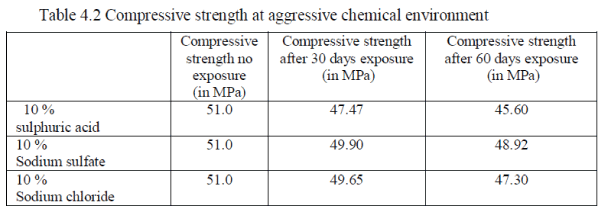 |
B. Loss of weight due to elevated temperature |
| The weight loss from geopolymer concrete composite increase with the increase in the maximum exposed temperatures due to accelerated drying. Up to the temperature of 100oC, concrete specimens lost 0.3 % of either initial weight due to the evaporation of free water. When the temperature was increased to 200oC, the weight loss was 0.972 %, and when the temperature was increased to 400oC, the weight loss was 2.855%. The increased weight loss is probably due to the loss of water from the geopolymer concrete. The thermal expansion of geopolymer concrete composite at elevated temperature is strongly affected by the expansion of aggregate because aggregates generally occupy75-80% of volume of concrete. The expansion of aggregates usually predominates over the contraction of geopolymer which produces a net result of expansion in the composite. At 600oC the concrete lost 3.94% of its weight. At 800oC the weight loss was 5.81 % while at 1000oC the weight loss arrived to 8.5 %. The relationship between the weight loss and maximum temperature is non- linear. |
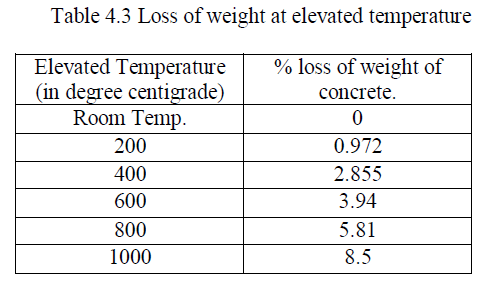 |
C. Loss of weight due to aggressive environment |
| Geopolymer concrete cubes were immersed in 10% concentration of sulphuric acid, 10% sodium sulfate solution and 10% sodium chloride for test period of 30 days and 60 days. All the exposed specimen recorded weight loss and it was observed that the weight loss in case of acid attack was less as compared to sulfate and chloride attack. The results of change in weight is presented in Table 4.4 |
 |
CONCLUSIONS |
| The experimental investigation confirms that: |
| • Loss of weight increased with increase in elevated temperature, weight loss was about 8.5% at 10000C. |
| • Geopolymer concrete composite showed deterioration in its properties when exposed to temperatures above 2000 C. |
| • Geopolymer concrete showed reduction in strengths in compression when exposed to high temperatures. This reduction was about 6.27%, 19.94%, 34.76%, 42.31% and 60.12 % at 200oC, 400 oC, 600 oC, 800 oC and 1000 oC degree respectively. |
| • Loss of weight due to acid, sulfate and chloride effect is 0.6135 %, 2.5 % and 1.23 % respectively after exposure of 30 days. |
| • Loss of weight due to acid, sulfate and chloride effect is 1.84 %, 4.37 % and 3.681 % respectively after exposure of 60 days |
| • Sulphuric acid attacks lead lesser loss of weight and also deposition of a white layer of a gypsum crystal on the acid exposed surface of the specimen. |
| • Geopolymer concrete showed reduction in strengths in compression when exposed to different aggressive chemical environment. This reduction was about 6.92%, 2.145% and 2.645% after 30 days exposure and 10.581%, 4.075 % and 7.245 % after 60 days exposure to acid, sulfate and chloride solution respectively. |
ACKNOWLEDEMENTS |
| The authors are grateful to Er. Shyam Deo Sharma & Er. Kumar Mani Bhushan (“BALAJI FLY ASH BRICKS PVT. LTD, JEHANABAD”) for introducing them to the fascinating topic and for their advice, encouragement and financial support. |
| We also thankful to Dr. V. Pandey (HOD), all teaching and non teaching staff of civil engineering department BIT Sindri, Dhanbad (Jharkhand). |
References |
|